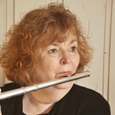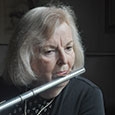Several months ago I was listening to the live Saturday afternoon Metropolitan Opera broadcast on the radio. I was expecting the opening notes of Puccini’s La Boheme, but instead Met General Manager Peter Gelb announced that Anita Hartig was ill, and Latvian soprano Kristin Opolais would be taking her place. Substitutions in major roles are not uncommon in the opera world, but what was unusual about this replacement was that Opolais had made her Met debut the night before singing the lead role in Madama Butterfly. She became the first singer in the Met’s 131 year history to make two major debuts in less than twenty-four hours.
The last time Opolais had sung La Boheme was at the Vienna State Opera in April 2013, which was almost a year before. However, this performance was with a different conductor, cast, and staging. After agreeing to perform on short notice, Opolais began her review of the score while being fitted for costumes and learning the new staging. According to the AP report, “At the end of the performance, Opolais covered her face and dropped to her knees to the stage, overcome with emotion during the five-minute ovation. In addition to the 4,000 people at the Met, her second debut was seen live by an estimated 92,000 in movie theaters in North America and 110,000 more in 32 nations in Europe, Africa, Asia, Latin American and the Caribbean.” Opolais was presented with an opportunity, and she accepted the challenge.
Substitutions in the symphonic world also are quite common; however, I have never heard a general manager come on stage and say, “Tonight the personnel changes will be first oboe, etc.” If there is a change in the concerto soloist, there will certainly be an onstage announcement. Now the question is, if the soloist becomes ill, are you prepared to fill in at the last moment?
There are two scenarios that could occur. If the soloist who cancels is a flutist, the management will hope that you can play the previously programmed concerto. Orchestral flutists should learn any programmed concertos they do not already know, just in case. This also may be helpful for rehearsals. I often have played the solo part for early rehearsals of a flute concerto prior to a guest flutist’s concerto appearance for the final rehearsal and concert.
A second scenario occurs when the soloist plays a different instrument. A prepared musician will have a concerto ready to offer. An important consideration is that the orchestral accompaniment will have to be readily available. I asked several prominent flutists who regularly solo with orchestras what the top five concertos are that a flutist should know and be able to perform straightaway. (See below)
In looking at these lists, I note that each flutist has included the Mozart G and D concertos. Not only are these concertos some of the best music ever written for the flute, but they are in the public domain which means that there will be no rental fees for the orchestral parts. Most orchestras own a score and set of parts for at least one of the two Mozart concertos; however, they may be an earlier Romantic printing. I have scores and bowed parts for these two concertos so in an emergency situation, with little or no rehearsal time, the conductor, orchestra and I will all be on the same page for style, articulation and dynamics.
The K.P.E. Bach, Vivaldi, and Reinecke concertos are also in the public domain, so the score and parts may be downloaded without charge from www.ismlp.org. The Chaminade Concertino is public domain in Canada and the United States, but not in the European Union. Similarly the Nielsen and Ibert are public domain in Canada, but are still under copyright in the United States which means the orchestral parts are available on a rental basis only.
As you might expect, if this is a last-minute substitution, the ease and expense of securing the parts is a consideration for the orchestra. As one concert artist remarked, “Make it easy for them to hire you.” Have a set of bowed and marked parts ready to go. If there is lead time and the orchestra has a rental budget, then you can select a concerto that requires rental parts.
Teachers may wonder what is the best way to prepare students to perform these concertos on short notice. Playing concertos well as an adult certainly stems from having been well-taught as a student. Encourage students to participate in competitions to obtain experience with solo and concerto performance. The more times students play well on stage, the better they can do it.
When a younger student has an opportunity to solo with a school or community orchestra, the first question is what to play. Both the playing level of the student and the orchestra should be considered. For the student I select a concerto that is well beneath the flutist’s technical and expressive abilities. It may be a concerto the student even considers easy. At this point the goal is to teach students to perform and conquer the situation and not to push technical prowess. Check with the orchestra conductor to gauge the ensemble’s playing level. Younger orchestras perform better with pieces that have block scoring, fewer off the string strokes and few independent parts as independent counting is a skill perfected later.
If the orchestra has a harpist, then the “Minuet” from the Georges Bizet’s L’Arlesienne Suite No. 2 is a good choice for the young soloist. Since both Suite No. 1 and No. 2 are often programmed on pops concerts, student flutists will certainly have opportunity to play this piece many times in the future.
Another piece that works well for younger players is the Gaetano Donizetti (1797-1848) Concertino for Flute and Orchestra. The flute part is almost identical to the Sonata for Flute and Piano version. This work, in C major, is delightful and virtuosic, but not too difficult for the orchestra and flutist. If performance length is a concern, then select movements from either the Georg Philip Telemann Suite in A Minor or the J. S. Bach Orchestral Suite No. 2. Other Baroque concertos that offer good preparation for future concerto performances are the G.B. Pergolesi Concerto in G, the C.P. Stamitz Concerto in G and concertos by Antonio Vivaldi.
The old saying “Mozart concertos are too easy for students and too difficult for professionals” is one to heed. While we are eager for students to play the Mozart Concertos, assigning them before students are ready means that future teachers will spend years ridding this music of poor habits. The concertos of François Devienne (No. 7 in E Minor), Sergio Mercadante (E Minor), and Fredrick Schwindl Concerto (D Major) offer an excellent gateway into playing in the classic style while saving the Mozart concertos for when the flutist is better equipped. If students have an oboist or flute friend, the Domenico Cimaroso Concerto in G for two flutes and the Antonio Salieri Concerto for Flute and Oboe are excellent choices for student soloists.
When orchestras are on tour, they are more apt to play encores than during the regular season. Often the principal flutist is asked to play a solo. Pieces such as Charles T. Griffes’ Poem, Kent Kennan’s Night Soliloquy, and Howard Hanson’s Serenade were favorites of legendary flutists William Kincaid (Philadelphia Orchestra) and Joseph Mariano (Rochester Philhar-monic). These are excellent pieces for flutists to learn during their later high school and college years.
If you are a teacher, this listing of the top five concertos can be used to motivate and inspire students to new heights. If you are a college student, realize that you cannot make a career by knowing only a handful of pieces including concertos. Start preparing now so that you can step in at the last moment.
* * *
Top Five Concertos a Flutist Should Know
Elizabeth Buck, Arizona State University flute professor and former Phoenix Symphony principal flute.
Mozart Concerto in G, K. 313
Mozart Concerto in D, K. 314
Nielsen Concerto for Flute and Orchestra, F.S. 119
Reinecke Concerto for Flute, Op. 283
Vivaldi (any one)
Jasmine Choi, Concert Artist and former Vienna Symphony principal flute.
J. S. Bach Orchestral Suite No. 2
Mozart Concertos in G, D, C
Reinecke Concerto for Flute, Op. 283
Rouse Concerto
Also has ready to go: CPE Bach E minor, Ibert, Mendelssohn, Khachaturian, Liebermann, Devienne, Stamitz, Haydn, Vivaldi, Saint-Saens, Mercadante
Marianne Gedigian, University of Texas-Austin flute professor and former acting principal Boston Symphony Orchestra.
Mozart Concerto in G, K. 313
Mozart concerto in D, K. 314
Nielson Concerto for Flute and Orchestra, F.S. 119
Ibert Concerto for Flute
Reinecke Concerto for Flute, Op. 283
Trudy Kane, University of Miami flute professor and former Metropolitan Opera principal flute.
Mozart Concerto in G, K. 313
Mozart Concerto in D, K. 314
Nielson Concerto for Flute and Orchestra, F.S. 119
Ibert Concerto for Flute
Mozart Concerto for Flute/Harp, Reinecke, Khachaturian, or Liebermann
Jeffrey Khaner, The Curtis Institute and The Juilliard School flute professor and Philadelphia Orchestra principal flute.
Mozart Concerto in G, K. 313
Mozart concerto in D, K. 314
Ibert, Concerto for Flute
Ranjbaran Flute Concerto
Leshnoff Flute Concerto
Conor Nelson, Bowling Green State University flute professor.
Nielsen Concerto for Flute and Orchestra, F.S. 119
Ibert Concerto for Flute
Mozart Concerto in G, K. 313
Mozart Concerto in D, K. 314
Mozart Concerto for Flute and Harp, K. 299
Joshua Smith, Cleveland Institute flute professor and Cleveland Orchestra principal flute.
Mozart Concerto in G, K. 313
Mozart Concerto in D, K. 314
Nielsen Concerto for Flute and Orchestra, F.S. 119
K.P.E. Bach or Vivaldi
Chaminade Concertino Op. 107 or Griffes Poem
Patricia George, Flute Talk Editor.
Mozart Concerto in G, K. 313
Mozart concerto in D, K. 314
Ibert, Concerto for Flute
Borne Carmen Fantasy
Nielson, Concerto for Flute and Orchestra, F.S. 119






